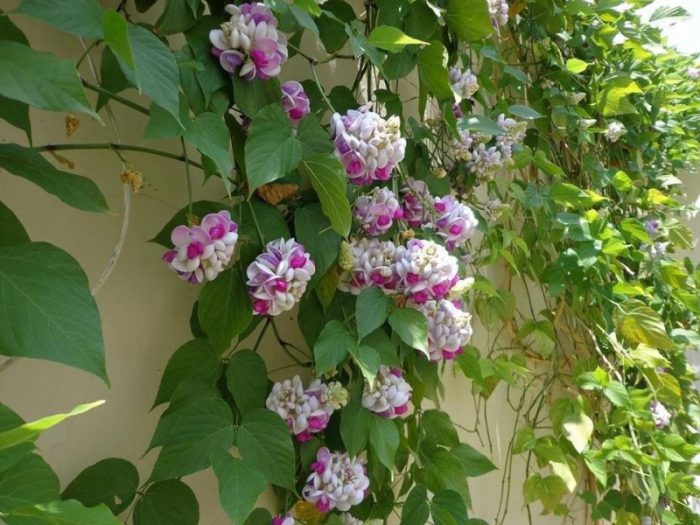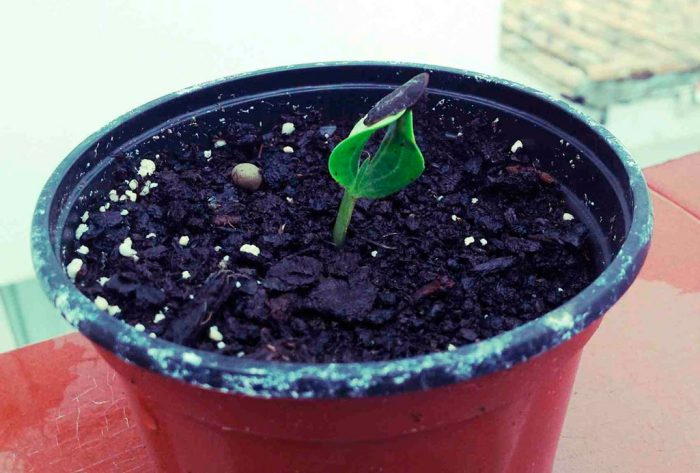A perennial plant like Vigna Caracalla (Vigna caracalla) is directly related to the legume family (Fabaceae). Vigna is translated as grape, and in Portuguese "caracol" means snail. This plant is also called vigna caracalla, snail grape, grape snail, corkscrew flower, and it also has many other similar names. This adorable plant is unusual. It is curly and very long (up to 7 meters). And also it has an unusual shape of flowers that are very similar to a snail or a corkscrew.
In the wild, this flower can be found in the tropics of Central or South America. In countries with warm climates, cowpea caracalla is grown as a perennial. In temperate climates, this plant, which is a bean, is grown as an annual, as well as a perennial (if warm indoor wintering is provided for it).
The growth of such a plant is distinguished by its rapidity. So, during the summer time, it is quite capable of completely braiding a net or a garden hedge, climbing over it. The stalks are not tied, since they themselves reliably cling to the antennae. The tripartite leaves have pointed tips, and they are colored dark green.
This plant is so popular due to its not quite ordinary lovely flowers. Their wavy petals are twisted into a very tight corkscrew. They can be colored purple streaked, pink, purple-white, and creamy yellow. On the same brush, both blossoming flowers and buds can be present. And also the caracalla cowpea flowers have a delicate aroma. Its bloom lasts from July to late autumn.
If you grow such a flower on the balcony, then it should be borne in mind that it will systematically need to cut the antennae and stems. After the shoots have reached the required length, they are pinched, which helps to stimulate flowering. The plant needs a very reliable support, such as a net or stretched cords. When choosing a place for the caracalla cowpea, it must be borne in mind that it is highly undesirable to move it, since the delicate shoots can be damaged.
Content
Care features
Illumination
Loves light, and with a lack of it, it stretches strongly and blooms very poorly.
Temperature
It is quite capable of withstanding a temperature drop of up to 3 degrees. If the plant is frozen, then its aerial part will die, but young shoots will begin to grow from the root system.
How to water
In the summer, water should be abundant, but waterlogging should be avoided.In winter, in indoor conditions, its growth practically stops, therefore, poor watering is needed.
Top dressing
During the active growth of the plant and flowering, it needs feeding. Fertilizers are applied to the soil every 2 or 3 weeks. Both organic and mineral fertilizers are suitable for this. And nitrogen-containing fertilizers are used only at the very beginning of the growing season.
Planting features and soil
Since the adult cowpea caracalla is quite impressive in size, you need to choose a large pot for it. The land must be well-drained and nutrient-rich.
Wintering
In winter, this plant is unattractive. It is better to keep it as a rhizome in a container, which must be placed in a cool place. And also in the form of cuttings rooted in the autumn. The growth of the flower at this time practically stops, so it just needs help to survive until spring.
Reproduction methods
The plant can be propagated by cuttings, seeds or layers.
Before sowing, the seeds are immersed in warm water for 24 hours. Then they are planted, buried in the soil by 2 centimeters, and the container is placed in a warm, well-lit place.
Before the cold weather sets in, cuttings are cut from the plant. They need to be planted in separate, not very large pots. Rooting usually occurs after 2 or 3 weeks. In winter, it grows poorly, and with the onset of spring, growth becomes active.
Pests
Can settle spider mite.














Please tell me where you can get seeds of Vigna caracalla (Vigna caracalla)
We do not trade in seeds, so we cannot tell
find the site favorite Pashka. he has seeds
hello! and if the above-ground part disappears, there is no chance? there were temperature drops, I think because of this, can sprout from under the root?